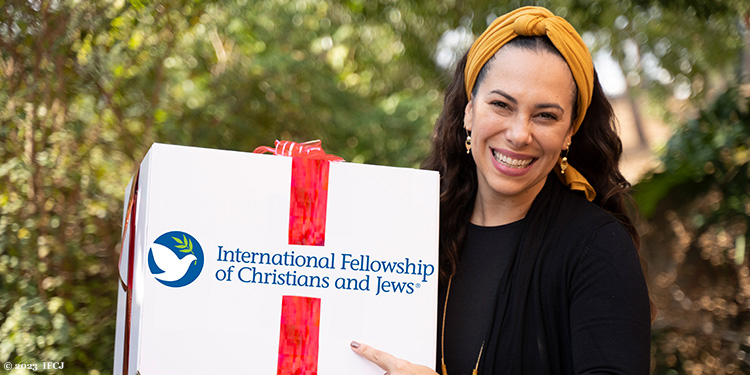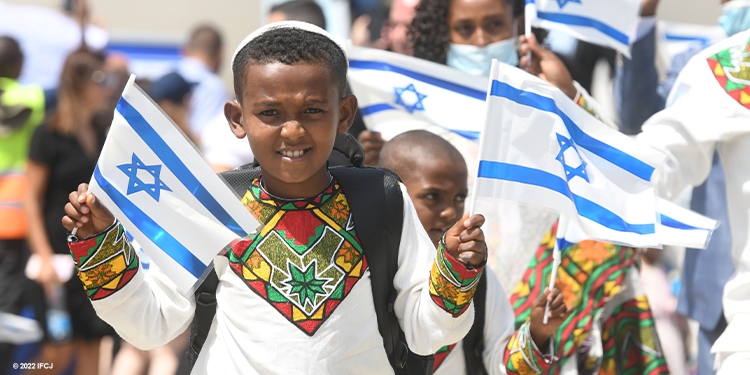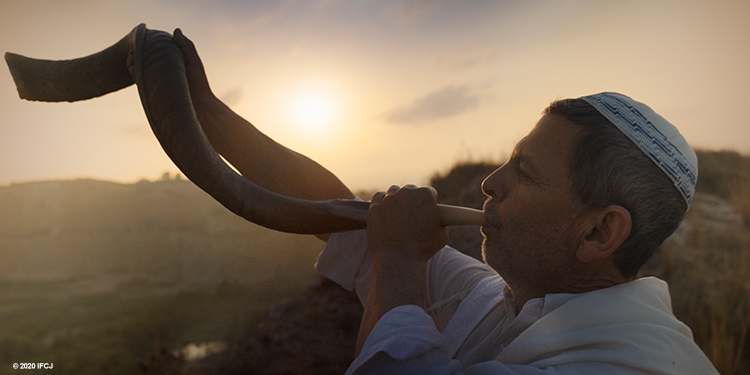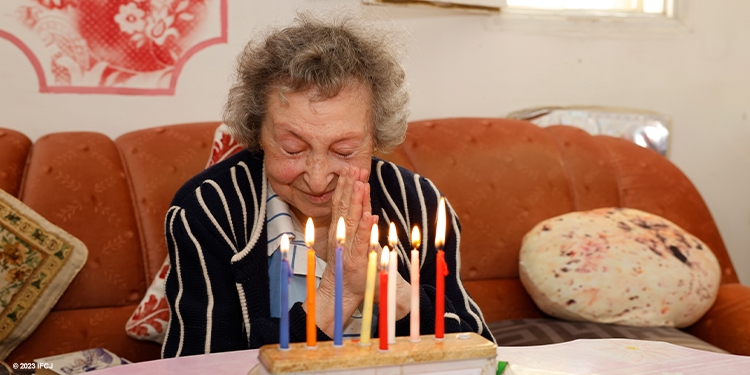What Are the Jewish Holidays?
The Fellowship | January 2, 2024

Jewish life centers around a cycle of holy observances and holidays that serve as markers and milestones throughout the year. Many of these days are holy, biblically mandated observances that have been faithfully followed since ancient times; some have been added since Israel became a nation in 1948. But all of these mo’ed, “appointed times,” define the very soul and fabric of what it means to be Jewish.
Learn more about the major holidays and observances that have defined the Jewish character in our overview. For in-depth information about each holiday, visit the Jewish Holidays section on the Learn Center.
It’s important to note that Jewish holidays begin at sundown on the evening of the date shown on the list below and conclude at sundown of the following day or the last day of the festival. All Jewish holidays also follow the Jewish calendar, which follows the lunar cycle, meaning time is marked by the moon’s monthly phases. For this reason, Jewish holidays fall on different days on the Gregorian calendar each year, but on the same day of the Jewish calendar every year.
Jewish Holiday List 2024
| Tu B’Shvat | New Year of the Trees | January 24 – 25 |
| Purim | The Festival of Lots | March 23 – 24 |
| Passover (Pesach) | The Exodus of the Jews | April 22 – 30 |
| Yom HaShoah | Holocaust and Heroism Remembrance Day | May 5 – 6 |
| Yom HaZikaron | Israel Memorial Day | May 12 – 13 |
| Yom HaAtzmaut | Israel Independence Day | April 25 – 26 |
| Yom Yerushalayim | Jerusalem Day | June 4 – 5 |
| Shavuot (Pentecost) | The Festival of Weeks | June 11 – 13 |
| Tisha B’Av | Destruction of the Temples | August 12 – 13 |
| Rosh Hashanah | The Jewish New Year | September 15 – 17 |
| Yom Kippur | The Day of Atonement | October 11 – 12 |
| Sukkot | The Festival of Tabernacles | October 16 – October 23 |
| Shemini Atzeret & Simchat Torah | The Eighth Day of Assembly and Rejoining in the Torah | October 23 – 25 |
| Hanukkah | The Festival of Lights | December 25 – January 3 |
Jewish Holiday Overview
Tu B’Shvat – The New Year of the Trees
Tu B’Shvat, the New Year of the Trees, is one of four “New Years” in the Jewish tradition. It falls on the 15th of the month of Shevat, which typically falls in late January-early February on the Gregorian calendar. This day celebrates the beginning of new life in trees when the sap begins to rise. In recent years, it has become custom for Jews in Israel to plant trees. You can learn more about how Tu B’Shvat is celebrated here.
Purim – The Feast of Lots

Purim recounts the events recorded in the Book of Esther and is also known as The Feast of Lots. Purim means “lots,” and it gets its name from the lots cast by the villain of the story to determine which day the Jews were to be annihilated. Esther, the heroine of the story, was a young Jewish girl who was chosen to be King Xerxes’ wife. During Xerxes’ reign, one of the king’s advisors, Haman, plotted to destroy all Jews. In a moment of courage, Esther told Xerxes of this plan and was able to save the Jews, her people. This holiday, one of the most joyous on the Jewish calendar, celebrates the redemption of the Jewish people from certain death.
Passover – Pesach, The Story of the Exodus
Passover is the most widely observed and celebrated holiday on the Jewish calendar. It commemorates the most important moment in Jewish history, when the enslaved Israelites were freed from Egypt and the nation of Israel was born. The story of the Exodus is one that many know—when God redeemed His children from slavery and Moses led the Israelites out from bondage. Moses and his people are an inspirational story for many — an affirmation for all people of faith that God protects, provides for, and deeply loves His people.
Yom HaShoah – Holocaust and Heroism Remembrance Day
Yom HaShoah was inaugurated in 1951 as a national holiday to memorialize the six million Jews murdered during the Nazi reign of terror. During the observance, flags are flown at half mast, and at 10 a.m., air raid sirens sound throughout the country and Israelis stop whatever they are doing to observe a two-minute silence of solemn reflection. Jews come together through prayer, the reading of Scripture, and the lighting of candles to remember those who died in the Holocaust.
Yom HaZikaron – Israel Memorial Day
Yom HaZikaron, Israel Memorial Day, is a somber remembrance of all the men and women who made the ultimate sacrifice of their lives to help form the new nation of Israel and to keep it alive over the past 75 years. The most noticeable feature of the day is the sounding of two sirens — one when the day begins at sundown and again at 11 a.m. during public prayer services at military cemeteries. During those times, the entire country comes to a standstill and observes a two-minute moment of silent reflection.
Yom HaAtzmaut – Israel Independence Day

Immediately following Yom HaZikaron is Yom HaAtzmaut, Israel Independence Day, a day of great celebration throughout the country. It was on the fifth day of the month of Iyar, May 14, 1948 on the Gregorian calendar, that the nation of Israel was re-established and Israel’s Declaration of Independence was signed in Tel Aviv. Yom HaAtzmaut celebrates this special day with parades, barbecues, and fireworks as a reminder to the Israeli people of their much sought-after freedom.
Yom Yerushalayim – Jerusalem Day
At the very center of the Jewish faith is the Holy City of Jerusalem. Both Holy Temples stood in Jerusalem, and it is in Jerusalem that Jews have celebrated their most joyous occasions and tragic moments. Jerusalem Day marks the historic reunification of this city when it was liberated in 1967 following the Six-Day War. It was the first time in thousands of years, since the Jews were exiled from Israel by the Romans, that all of the city was once again under Jewish sovereignty. The day is celebrated with special prayers, pilgrimages to Jerusalem, and a general outpouring of gratitude to God for this miracle that the people of Israel will never take for granted.
Shavuot – Pentecost, the Festival of Weeks
Shavuot (also known as Pentecost) occurs 50 days after Passover. Called The Feast of Weeks in the Bible, Shavuot originally marked the beginning of the spring harvest for the Israelites with a celebration at the Holy Temple in Jerusalem. Following the destruction of the Holy Temples, this day then focused on the anniversary of the giving of the Torah (the first five books of the Hebrew Bible) to Moses on Mount Sinai. The holy days of Shavuot and Passover are connected, with the time in-between known as The Counting of the Omer, 50 days of anticipation between celebration of the people’s physical redemption from slavery and their spiritual redemption as children of God with the giving of His Word.
Tisha B’Av – The Fast of the Ninth of Av
Tisha B’Av, the Ninth day of the month of Av, commemorates the darkest day on the Jewish calendar — the destruction of the two Jerusalem Temples which occurred on the same day hundreds of years apart. It is a day of communal mourning not only for the destruction of the Holy Temples, but also for the many tragedies that have befallen the Jewish people that have occurred on the ninth of Av. Tisha B’Av is one of two full fast days on the Jewish calendar (the other is Yom Kippur) and is marked by observing Jewish mourning traditions and prayer.
Rosh Hashanah – Jewish New Year

Rosh Hashanah, the Jewish New Year, is celebrated on the first day of the month of Tishrei and, along with Yom Kippur, is known as the High Holy Days. It is a holy observance marked by intense moral and spiritual reflection as the Jewish people prepare for God’s judgment, which is sealed ten days later on Yom Kippur, the Day of Atonement. During the ten days between, known as the Days of Awe or Days of Repentance, the Jewish people reflect on past mistakes and how they can improve in the year to come. The sound of the shofar (the biblical trumpet made of a ram’s horn), which resounds throughout the High Holy Days, is a call for repentance.
Yom Kippur – Day of Atonement
Yom Kippur, the Day of Atonement, is the holiest day of the Jewish year and is the culmination of the High Holy Days, which begins with Rosh Hashanah, the Jewish New Year. It marks the final opportunity to repent before God before the Book of Life is sealed for another year. The day is marked by fasting and spending time in synagogue, beseeching God for forgiveness through the words of a special liturgy that is used every year only on this day.
Sukkot – Festival of Tabernacles
The Festival of Tabernacles, Sukkot, is a seven-day festival for the Jewish people that takes place only days after Yom Kippur concludes. In contrast to the solemnity of the High Holy Days, Sukkot is a joyous celebration that commemorates the time when the Israelites wandered through the Sinai desert after the Exodus on their way to the Promised Land. The holiday focuses on God’s providence and provision for the Israelites during that time. As they did in biblical times, the holiday is marked with the building of a sukkah, a temporary outdoor shelter ope-n to the elements, where Jewish families eat, share fellowship, and even sleep during the week-long celebration.
Shemini Atzeret & Simchat Torah – The Eighth Day of Assembly & Rejoicing in the Torah
The eighth day after Sukkot is known as Shemini Atzeret and it marks the transition of the High Holy Days to the year ahead by reminding the people not to leave God behind. The next day is Simchat Torah, which means Rejoicing in the Torah, which celebrates the completion of the annual reading of the Torah and the beginning of a new cycle of reading from Genesis to Deuteronomy. God’s Word is the vehicle through which the Jewish people bring that holiness and inspiration into daily life.
Hanukkah – Festival of Lights

Hanukkah, one of the most joyous festivals of the Jewish calendar, is the only holiday not mentioned in the Torah, although it is mentioned in the Christian Bible (John 10:22). The observance celebrates the miraculous victory of the Maccabees against the mighty Greek/Syrian army. After their astonishing victory, the Jewish people went into the Holy Temple, which had been defiled by the Greeks. When the Jews went to light the Temple menorah, as commanded by God, they only had oil for one day. However, they lit the menorah in faith and a miracle happened —the oil lasted for eight days and nights, until more pure oil could be procured. Jews today commemorate those miraculous events by lighting their own menorahs over the eight nights of Hanukkah and preparing special foods fried in oil, such as latkes (potato pancakes).
Learn more about these holy days and special observances when you visit our Jewish Holidays section on the Learn Center.
